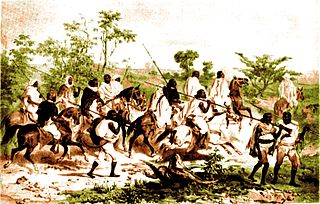Tekle Giyorgis II was Emperor of Ethiopia from 1868 to 1871.
Tekle Haymanot II was Emperor of Ethiopia as Admas Sagad III, and a member of the Solomonic dynasty. He was the son of Yohannes II by Woizero Sancheviyar, at the Imperial prison of Mount Wehni.

Tekle Giyorgis I was Emperor of Ethiopia intermittently between 20 July 1779 and June 1800, and a member of the Solomonic dynasty. He was the youngest son of Yohannes II and Woizoro Sancheviyer, and the brother of Tekle Haymanot II.
Salomon II was nəgusä nägäst of Ethiopia. He was the son of Abeto Adigo. He may be identical with the Emperor Solomon whom the traveler Henry Salt lists as one of the Emperors still alive at the time of his visit in 1809/1810.
Iyasu III was Emperor of Ethiopia from 16 February 1784 to 24 April 1788, and a member of the Solomonic dynasty. He was the son of Abeto Azequ, and the grandson of Iyasu II.
AtseBaeda Maryam was proclaimed Emperor of Ethiopia in Tigray and Gojjam by Dejazmach Wolde Gabriel, the son of Ras Mikael Sehul, who was opposed to Ras Ali of Begemder.
Hezqeyas was Emperor of Ethiopia from 26 July 1789 to January 1794, and a member of the Solomonic dynasty. He was the son of Iyasu III.
Baeda Maryam II was Emperor of Ethiopia from 15 April to December 1795. He may have been the son of Salomon II. Although E. A. Wallis Budge, in his book A History of Ethiopia: Nubia and Abyssinia, notes some authorities believe Baeda Maryam was the same person as Salomon III, Nathaniel Pearce, who met the former Emperor when he visited Ras Wolde Selassie 20 January 1813, states that he had been Emperor only once, for nine months.
Salomon III or Solomon III was the Emperor of Ethiopia and a member of the Solomonic dynasty. He was the son of Tekle Haymanot II. He may be identical with the Emperor Solomon whom the traveler Henry Salt lists as one of the Emperors still alive at the time of his visit in 1809/1810. E. A. Wallis Budge notes some authorities believe he was the same person as Baeda Maryam II.
Demetros or Demetrius was Emperor of Ethiopia from 25 July 1799 to 24 March 1800 and from June 1800 to June 1801. He was the son of Arqedewos. He may be the same person as the "Adimo" mentioned in the account of the traveler Henry Salt who was dead by the time of Salt's visit to northern Ethiopia in 1809/1810.
Yonas or Jonas was nəgusä nägäst of Ethiopia. He was the son of Letezum, and the grandson of the Emperor Fasilides.
Egwale Seyon or Gwalu (ጓሉ) was nəgusä nägäst of Ethiopia, and a member of the Solomonic dynasty. He was the son of Hezqeyas.
Sahle Dengel was Emperor of Ethiopia intermittently between 1832 and 11 February 1855, towards the end of the Zemene Mesafint. He was the son of Gebre Mesay, allegedly a descendant of a younger son of Emperor Fasilides.
Gugsa of Yejju was a Ras of Begemder, and Inderase (regent) of the Emperor of Ethiopia. According to Nathaniel Pearce, he took the Christian name of Wolde Mikael. He was the son of Mersu Barentu and Kefey, the sister of Ras Aligaz. Both Bahru Zewde and Paul B. Henze consider his reign as Ras and Enderase as the peak of the Yejju Dynasty during the Zemene Mesafint.
Yimam of Yejju was a Ras of Begemder and Enderase (regent) of the Emperor of Ethiopia. He was the son of Gugsa of Yejju.
Ali I of Yejju was Ras of Begemder, and following the death of Ras Mikael Sehul, Regent of the Emperor of Ethiopia. He was the son of Abba Seru Gwangul, chieftain of the Yejju, and Woizero Gelebu Faris, daughter of Ras Faris of Lasta.
Ali II of Yejju was a Ras of Begemder and Enderase (Regent) of the Emperor of Ethiopia. He was the son of Alula of Yejju and Menen Liben Amede and nephew of Gugsa of Yejju.
Wolde Selassie was Regent of the Ethiopian Empire. John J. Halls, in his Life and Correspondence of Henry Salt, preserves a description of this powerful warlord, as "small in stature, and delicately formed, quick in his manner, with a shrewd expression, and considerable dignity in his deportment." Nathaniel Pearce also notes that Ras Wolde was an avid chess player, and "would play at from morning till night".
The Battle of Debre Tabor was a conflict during the Zemene Mesafint in 1842 initiated by Dejazmach Wube Haile Maryam to overthrow Ras Ali II as Regent of the Emperor of Ethiopia and gain control of Ethiopia. This confused battle was won by Ras Ali, but at a steep price, and this victory failed to cement his position as the most powerful nobleman of his time.

The Zemene Mesafint was a period in Ethiopian history between the mid-18th and mid-19th centuries when the country was de facto divided within itself into several regions with no effective central authority. It was a period in which the Emperors from the Solomonic dynasty were reduced to little more than figureheads confined to the capital city of Gondar.